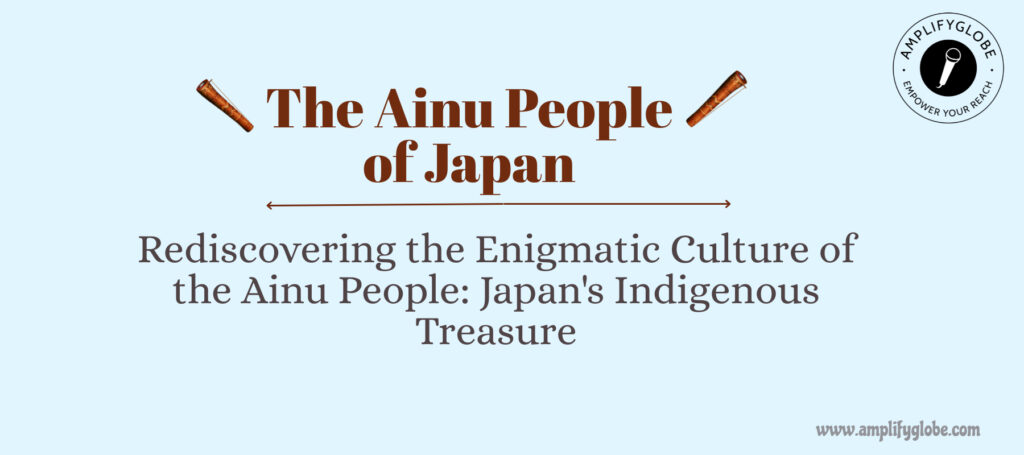Japan, renowned for its cultural diversity and historical heritage, is home to several ethnic groups. Each group has its unique customs and traditions. Among these captivating groups, the Ainu people of Japan, an indigenous community residing in the northern regions of Japan, hold a distinct and fascinating culture. It deserves recognition and understanding.
In this blog, we will delve into the intriguing world of the Ainu people, exploring not only their history, customs, and language but also their commendable efforts to preserve their cultural identity in the modern world. Moreover, we will shed light on the challenges they have faced throughout history and discuss the significance of their cultural heritage in today’s global context.

Embrace the beauty of cultural diversity and enrich your understanding of the world! Learning about different cultures is an enriching journey that broadens our perspectives, fosters empathy, and fosters respect for one another. It allows us to appreciate the unique traditions, values, and customs that shape the identity of various communities around the globe. Learn about the Sami, the Akha People, the Aymaraes, the Kazakh People and the Adivasi.
The Ainu People of Japan: A Brief Historical Overview
The Ainu people have a rich history that stretches back thousands of years, which predates the unification of Japan as a nation. Furthermore, anthropologists believe that the Ainu are descendants of the Jomon culture, the prehistoric inhabitants of Japan. Additionally, their unique physical characteristics, language, and cultural practices set them apart from the dominant Yamato population.
Historically, the Ainu people inhabited a vast territory encompassing the northern regions of Japan, including Hokkaido, parts of Honshu, and the southern area of the Russian Far East. They lived in these areas as an indigenous ethnic group rich cultural traditions and customs. However, as Japan’s centralized government expanded its influence, the Ainu faced significant cultural assimilation and marginalization. During the Meiji period (1868-1912), intensified efforts were made to integrate the Ainu into the broader Japanese society. These efforts led to a decline in their traditional practices and language.
Ainu Culture of Japan: A Glimpse into the Past
1. Traditional Clothing and Adornments:
The Ainu people boast a distinctive style of clothing. It is meticulously woven from fibers of trees, such as the inner bark of the Japanese white birch. These garments are adorned intricate patterns and motifs representing various aspects of Ainu life.

These aspects include animals, plants, and natural phenomena. They are a beautiful reflection of the Ainu culture and traditions. Notably, Ainu women historically adorned themselves tattoos on their mouths and arms. Regrettably, this ancient practice diminished due to cultural suppression.
2. Spiritual Beliefs:
A deep spiritual connection nature is a fundamental aspect of Ainu culture. Moreover, animism, the belief in the spiritual significance of natural objects and phenomena, lies at the core of their spiritual beliefs. Mountains, rivers, trees, animals, and celestial bodies are revered as sacred entities, and rituals and ceremonies are performed to express respect and gratitude to these elements.
3. Ainu Language:
The Ainu language is a unique and isolated language no known relation to other languages in Japan or the surrounding regions. It plays a central role in the Ainu people’s cultural identity. However, over the years, the number of Ainu speakers has significantly dwindled, only a few elders retaining fluency. In recent times, commendable efforts have been undertaken to revitalize the Ainu language and promote its usage among younger generations.
4. Traditional Music and Dance:
Ainu music and dance are vibrant expressions of their cultural heritage. They employ various musical instruments, such as the mukkuri (a traditional mouth harp), tonkori (a stringed instrument), and upopo (a wooden percussion instrument). These performances often depict hunting scenes, fishing, and other aspects of daily Ainu life.
Preservation and Revival of Ainu Culture
Despite facing cultural assimilation and discrimination, the Ainu people have fervently strived to preserve and revive their heritage. With growing awareness of their unique identity, there have been notable efforts to celebrate Ainu culture and promote understanding and acceptance.
1. Ainu Cultural Centers:
Ainu cultural centers have been established across Hokkaido and other regions Ainu communities. Moreover, these centers serve as repositories of traditional knowledge, arts, and crafts, preserving invaluable aspects of Ainu culture. Additionally, they provide a platform for Ainu artists and artisans to showcase their talents, ensuring their cultural legacy lives on.
2. Recognition and Rights:
In a significant step towards acknowledgment and preservation, Japan officially recognized the Ainu people as an indigenous group in 2008, recognizing their distinct culture and heritage. Subsequently, the Ainu Culture Promotion Act in 2019 aimed to protect and promote Ainu culture, language, and traditional practices, paving the way for cultural resurgence.
3. Ainu Tourism and Education:
In recent years, there has been a surge in interest among tourists and locals seeking to learn about Ainu culture. Consequently, cultural tours, workshops, and performances have become popular attractions, allowing visitors to gain insights into the unique aspects of Ainu life and fostering cultural exchange and understanding.
4. Cultural Revival through Art and Media:
Ainu artists, writers, and filmmakers have played an instrumental role in reviving and sharing their culture the world. Through art, literature, and media, they skillfully highlight the struggles and triumphs of the Ainu people, fostering empathy and understanding among wider audiences and consequently raising global awareness of Ainu culture. Additionally, these creative expressions serve as powerful tools in preserving the rich heritage and traditions of the Ainu community for future generations.
Parting Shot
The Ainu people’s culture, its profound connection to nature and reverence for ancestral traditions, stands as a valuable and irreplaceable part of Japan’s identity. Despite the challenges of cultural assimilation, the Ainu community’s unwavering determination to preserve and revive their heritage has garnered recognition and support in recent years.
As global consciousness regarding the importance of cultural diversity and indigenous rights grows, the unique identity and contributions of the Ainu people to Japan’s cultural tapestry gain long-overdue appreciation. By collaborating the Ainu community, the Japanese government, and society as a whole, we can ensure that the enchanting culture of the Ainu people endures for generations to come. Additionally, fostering partnerships and mutual understanding will be essential in preserving their unique traditions and heritage. This collaboration will not only enrich Japan’s cultural landscape but also inspire the world its timeless wisdom and beauty.